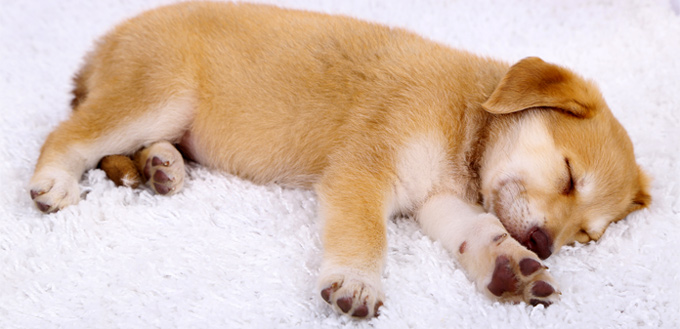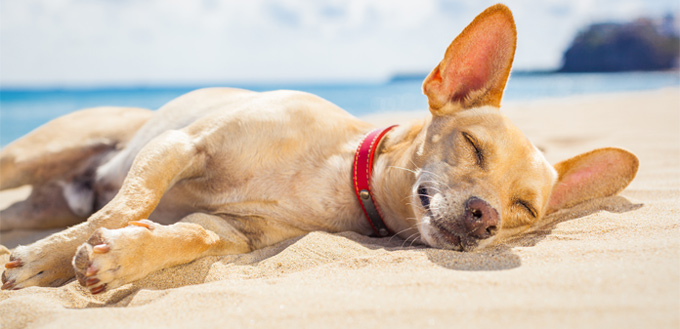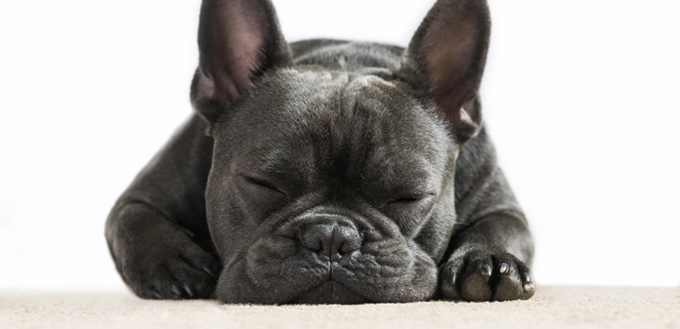Isn’t it cute to see your dog running in its sleep? Your dog may even take you on an adventure as well.
So, why do dogs actually run in their sleep?
Why do Dogs Run in Their Sleep?
Sleep is an important function in our lives and something that is essential for our physical and mental well-being. Have you ever tried being awake for a straight 40 hours? How do you feel?
Your dog feels the same way too because humans and dogs are 95% genetically and physically identical. This is why sleep pattern is similar between humans and dogs and determines how they act during wake times.

Just like humans, dogs dream a lot too. They have dreams about their everyday activities, fears, and emotions. These different feelings manifest themselves during sleep and this explains why dogs run.
To understand more on this phenomena, let’s see what the sleep pattern is like for dogs and what are the factors that impact it.
Sleep Pattern of Dogs
The sleep patterns of adult dogs depend on the age, activities of the dog, the size of the pet and its overall health and well-being.
- Size
Large dogs tend to sleep more than small dogs because their bodies need more rest because of their larger size. Even a simple one-hour walk can send your pooch into a long afternoon nap!
- Age
Again, age has a major impact on the sleep. In general, older dogs tend to sleep more because their rate of metabolism is slower and they do not have the energy for physical activities. In this sense, it is similar to what happens in humans too. Seniors tend to have multiple naps through the day when compared to someone in their 20s and 30s. And this is for the same reason.
Similarly, puppies tend to sleep more than adult dogs because sleep helps their physical organs, senses, and brain to mature. Human babies too sleep for a long time during the first few months and as they grow, the number of naps go down.
Thus, age is a big factor in a dog’s sleep pattern. Very young and very old dogs tend to sleep more than adult dogs.
- The pattern itself
Another important difference between dogs and humans is the amount of time spent in the “REM” state. “REM” state is the stage where a lot of active dreaming occurs. In humans, this constitutes about 25% of our total sleep cycle whereas in dogs, it is only 10%. This is why the sleep doesn’t refresh them as much and they need about 12 to 14 hours of sleep a day.
In general, dogs experience two types of sleep stages – REM and slow wave sleep (SWS). The SWS is the initial stage of sleep where the functions slow down, but the brain is still active. REM sleep is the deeper stage of sleep.
Brain waves recorded during a dog’ s sleep show that the physical activity is a manifestation of the dream state. This means, your dog runs in its sleep because it had a dream about chasing an animal, running away from another animal or maybe even just running towards you! Since the physical activity is a manifestation of its dream, the dog just executes it even while sleeping.
- Exercise
Exercise is an aspect that is believed to have some bearing on the dog’s sleep patterns and its dreams.

As a rule, your dog needs a minimum of 30 minutes of exercise every day, though large and working breeds like watchdogs need more activity to keep them alert. When your dog is tired, it tends to sleep more and maybe even spending more time in a deep sleep stage. This could trigger dreams that can, in turn, make your dog run in their sleep.
- Seizures
While the above causes are benign and maybe even fun for your dog, there is one pattern that you should watch out for.
Sometimes, dogs run when they have seizures in their sleep. The good news is it is easy to identify seizures as they are very different from a normal running stride. If you notice a pattern of seizures, make a note of it and take your dog to the vet right away.
It is important you have a log of the dates and times of the seizure, as this will help the vet to identify the root cause of the behavior. The vet may take a few tests and may even keep the dog under observation for some time, before deciding on the next course of action. Usually, medication is given to counter seizures and you will have to watch out for patterns again, to tell your doctor if these seizures have increased or decreased in frequency.
What Can You Do?
The honest answer is nothing. There is nothing you can do about your dog’s dreams because this is a normal body function that probably even your dog doesn’t have any control over!
But one thing that you can do is help your dog to have positive dreams by spending time and giving a ton of love and affection to it. This way, your dog will have positive dreams and maybe it is running towards you in his dreams instead of running away from some fear.

You can also give a peaceful environment for your dog to sleep, so there is little disturbance or noise. A soft warm bed would also be ideal for your dog to sleep well.
Related Post: Best Heated Dog Bed
In short, your dogs run in their sleep because of a dream or an instinct that they experienced. There is nothing much you can do about it, except sit back and enjoy the fun of seeing your dog run with its eyes closed.
Remember, you and your dog have a ton of similarity in the way you sleep, so be considerate and spend some quality time with your pooch, so it has positive dreams and a happy life.
Sources:
- Anna Burke, Why Do Dogs Twitch in Their Sleep?, The American Kennel Club
- Nicole Pajer, Why Do Dogs Twitch in Their Sleep?, PetMD







